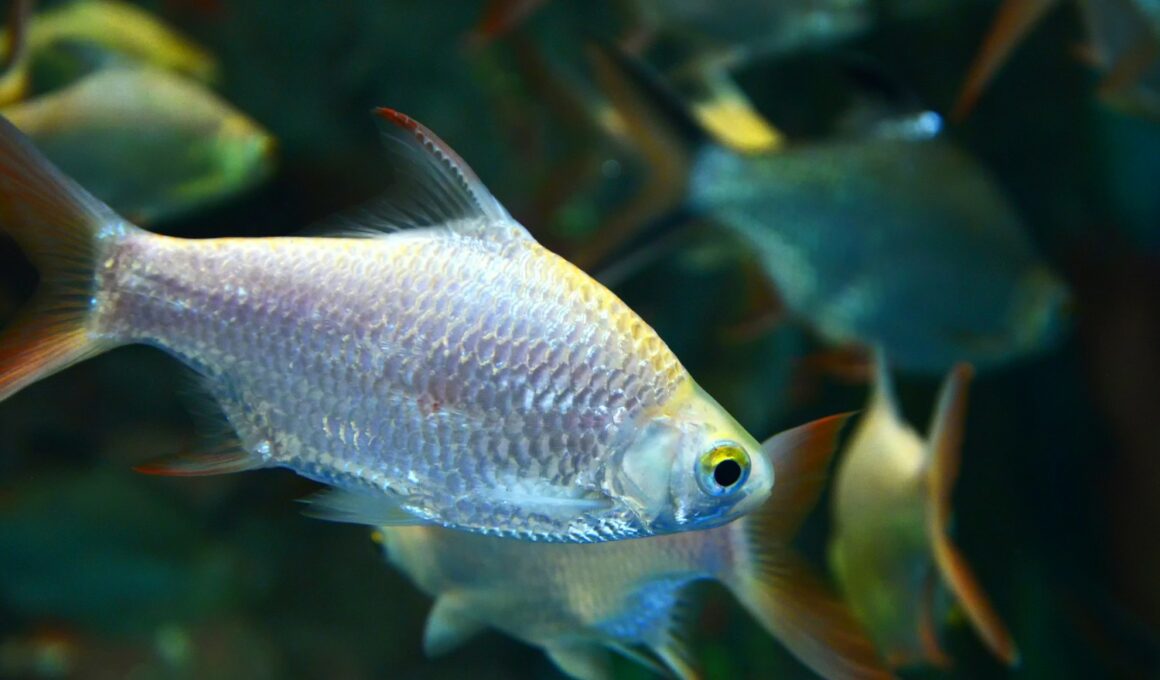In this article Show
As a seasoned fishkeeper, I’ve always been captivated by the vibrant and dynamic nature of Barbs. These little swimmers, with their burst of colors and active demeanor, are often a favorite in many home aquariums. But just like in any community—be it underwater or on dry land—harmony is key.
If you’re reading this, chances are you’ve got a tank filled with Barbs or you’re considering starting one. And now, you’re probably pondering, “Who would make the best neighbors for my lively Barbs?”
As we dive into this guide, I’ll share with you not only the best tank mates for your Barbs but also some practical advice and insights I’ve gathered over the years. Remember, the key is to create a balanced, stress-free environment for all your finned friends.
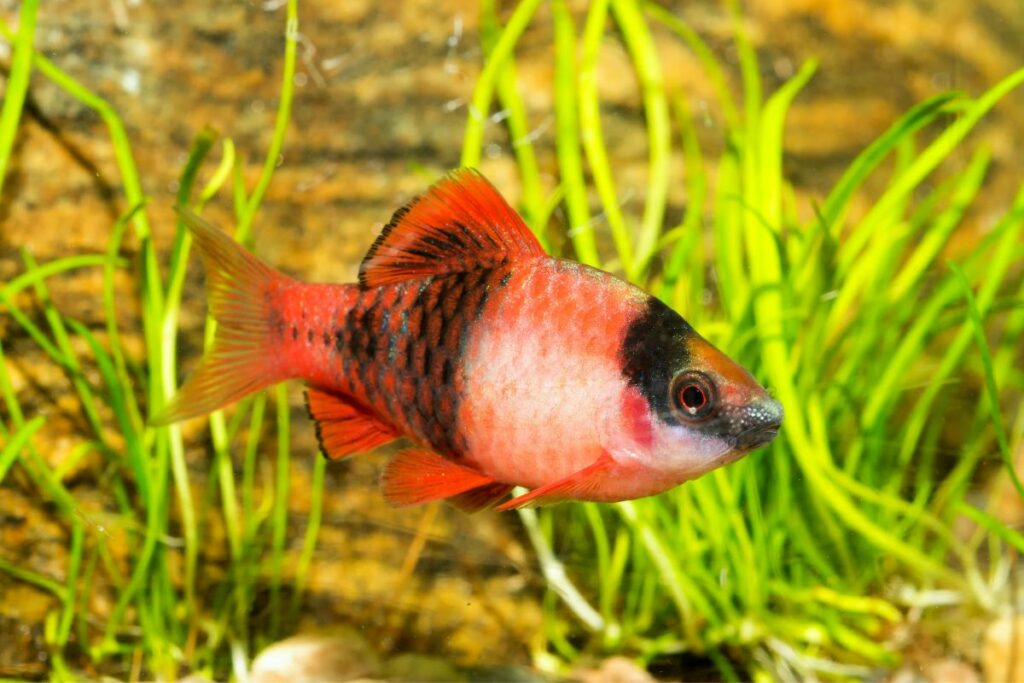
Understanding the Nature of Barbs
Barbs, hailing from the Cyprinidae family, are among the most spirited and dynamic fishes you can introduce to your aquarium.
Their active nature makes them an eye-catching addition, often seen darting from one corner of the tank to another, exploring every nook and cranny. Observing them can be akin to watching an underwater ballet, with their swift movements and energetic displays.
However, as is often the case with such vivacity, there’s a flip side. While they’re mostly peaceful, Barbs do have a reputation for being somewhat nippy.
Especially during feeding times or when they feel threatened or cramped, they might occasionally nip at the fins of other fish. This behavior, though not aggressive per se, can cause stress to other tank inhabitants if not properly addressed.
This ‘nippiness’ isn’t a reflection of an inherent meanness but more about their active, curious, and sometimes territorial nature.
Understanding this aspect of their behavior is crucial. Why? Because a stressed fish is not a healthy fish. And if the Barbs’ playful nipping is causing anxiety among other tank mates, it can lead to illness or even shortened life spans.
This is precisely why the companionship you choose for your Barbs is paramount. The right tank mates can coexist with the Barbs, understanding their spirited antics without being overly affected by them.
General Tank Conditions for Barbs
Crafting the right environment for your Barbs isn’t just about pairing them with the right fishy friends. Their immediate surroundings play a pivotal role in their well-being.
By ensuring proper tank conditions, you not only ensure their longevity but also reduce the chances of aggressive or stressed behaviors. So, what makes for an ideal Barb environment? Let’s explore.
1. Size Requirements
A minimum of 20 gallons is recommended for most Barb species, especially the smaller ones. However, if you’re housing the larger Barb species or want to keep a school, a tank of 30 gallons or more is preferable. Remember, Barbs are active swimmers and will appreciate the extra space to roam.
2. Water Parameters
- Temperature: Barbs thrive in temperatures ranging from 74°F to 80°F. A good quality heater and thermometer are essential to maintain consistent temperatures.
- pH Level: A pH range of 6.0 to 7.5 is ideal for most Barb species. It’s always a good practice to test the water’s pH regularly to ensure it remains within this range.
- Hardness: Barbs are relatively adaptable but prefer soft to moderately hard water. A general hardness (GH) of 4 to 12 dGH is recommended.
3. Tank Setup
- Substrate: A fine-grained substrate, such as sand or soft gravel, is preferred. This allows Barbs to forage without injuring themselves.
- Plants: Barbs love a planted tank! Plants not only provide hiding spots but also aid in water filtration. Ensure you have a mix of both floating and rooted plants. Java moss, Amazon swords, and water wisteria are some favorites among Barb keepers.
- Decor: Rocks, driftwood, and caves make for excellent additions. They give Barbs territories and refuges, which can reduce nippy behaviors.
- Filtration: Given their active nature, Barbs produce a fair amount of waste. A good-quality filter, capable of handling the tank’s volume, is crucial to maintain water clarity and remove waste effectively.
Best Barbs Fish Tank Mates
Barbs, with their lively nature and vivid hues, are a centerpiece in many aquariums. However, their energetic disposition necessitates careful selection of tank mates to ensure a balanced, stress-free environment.
Discovering the ideal companions for Barbs can enhance the visual allure of your tank while promoting a serene coexistence among its inhabitants. Dive in as we explore the best tank mates to accompany your spirited Barbs.
1. Tetras

| Attribute | Description |
| Size | 1 to 2.5 inches (varies by species) |
| Diet | Omnivore |
| Temperament | Peaceful to Semi-Aggressive |
| Care Level | Easy to Intermediate |
| Minimum Tank Size | 10 to 20 gallons (varies by species) |
Tetras are among the most colorful, diverse, and widely recognized species in the freshwater aquarium hobby. Hailing from South America, Central America, and West Africa, they have over the years become a favorite for aquarists worldwide.
Their small size, vibrant colors, and mesmerizing schooling behavior make them an attractive choice for community tanks.
The good news is that many Tetra species get along swimmingly with Barbs. Their similar active nature means they understand each other’s energy and can coexist without much hassle. However, it’s essential to pick the right Tetra species.
2. Danios
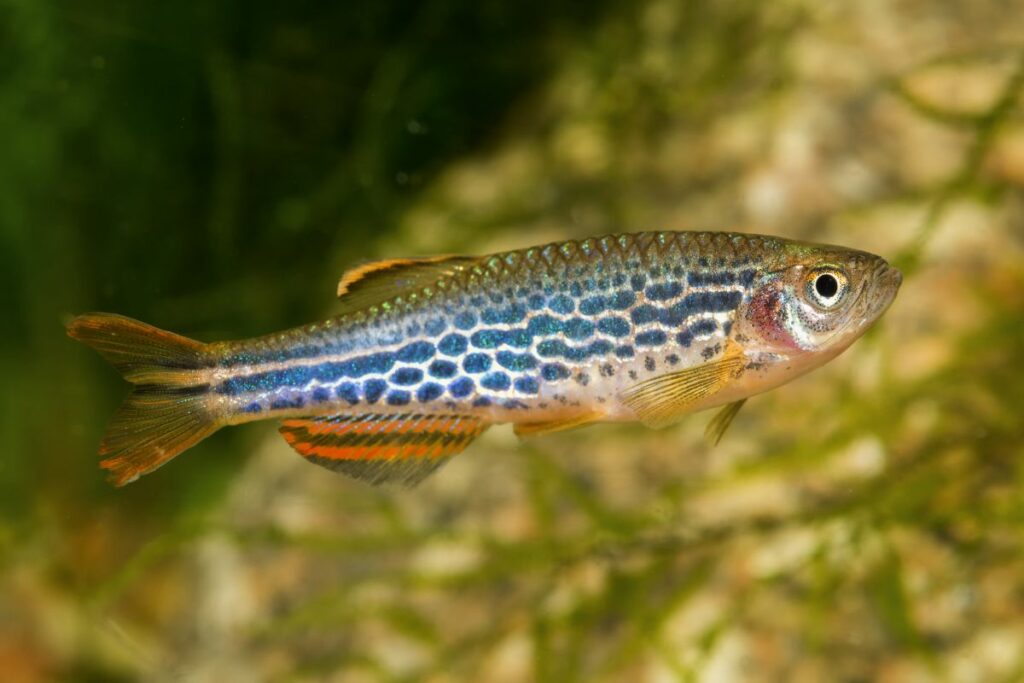
| Attribute | Description |
| Size | 1 to 4 inches (varies by species) |
| Diet | Omnivore |
| Temperament | Active and Peaceful |
| Care Level | Easy |
| Minimum Tank Size | 10 gallons |
Originating from Southeast Asia’s freshwater bodies, Danios are renowned for their striking patterns and swift swimming capabilities. These slender-bodied fishes are an embodiment of energy and are frequently seen zipping around the top or middle layers of the aquarium.
3. Loaches
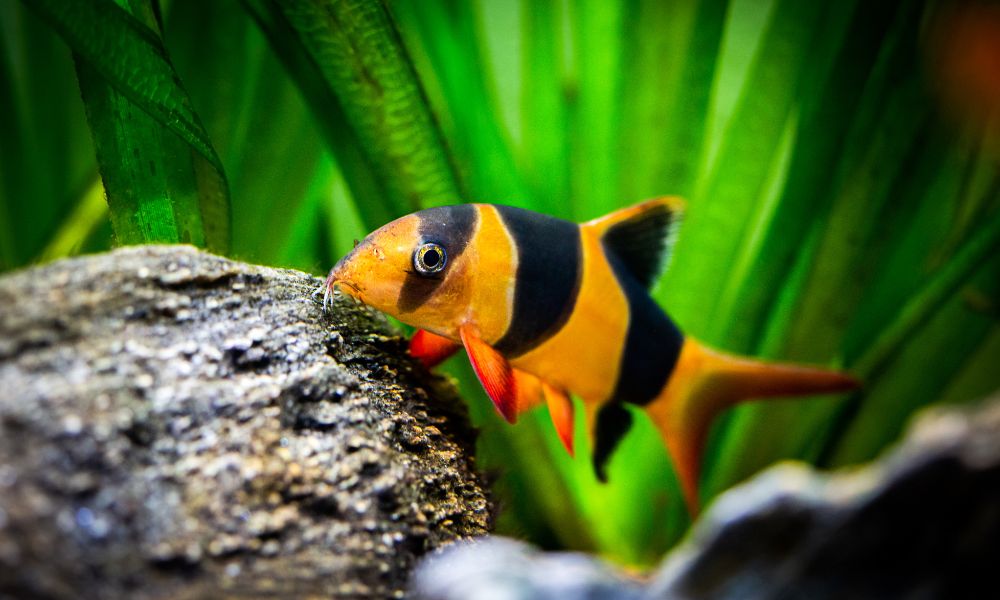
| Attribute | Description |
| Size | 2 to 12 inches (varies by species) |
| Diet | Omnivore |
| Temperament | Peaceful |
| Care Level | Intermediate |
| Minimum Tank Size | 20 gallons (varies by species) |
Loaches are an intriguing addition to any aquarium due to their unique shapes, behaviors, and fascinating patterns.
Originating from various parts of Asia, these bottom-dwellers have a diverse range of species. While there are many types of loaches, one of the most popular and compatible with Barbs is the Kuhli loach.
4. Corydoras Catfish
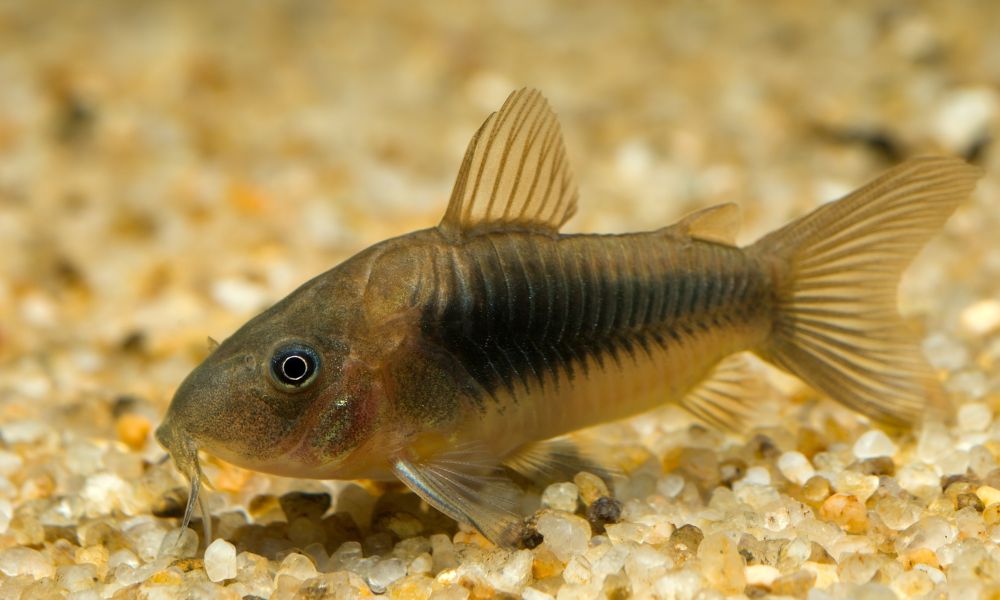
| Attribute | Description |
| Size | 1 to 4 inches (varies by species) |
| Diet | Omnivore |
| Temperament | Peaceful |
| Care Level | Easy to Intermediate |
| Minimum Tank Size | 20 gallons (varies by species) |
Corydoras catfish, affectionately known as “Corys” among aquarists, are a charming and hardy group of bottom-dwelling fish.
Native to South America’s slow-moving waters, these armored catfish have an array of species with distinct patterns, sizes, and colors. Their gentle nature and industrious bottom-scavenging behavior make them a popular choice in freshwater community tanks.
5. Rasboras

| Attribute | Description |
| Size | 1 to 4 inches (varies by species) |
| Diet | Omnivore |
| Temperament | Peaceful |
| Care Level | Easy to Intermediate |
| Minimum Tank Size | 10 gallons (larger for groups) |
Rasboras are small, brightly colored freshwater fish known for their peaceful and gentle disposition. Hailing primarily from Southeast Asia, these fish are schooling by nature, often moving gracefully in coordinated groups that add a mesmerizing, harmonious feel to aquariums.
Their calm temperament makes them less prone to nipping or bothering tank mates, making them an excellent choice for community tanks.
Their preference for staying in groups not only provides a sense of security but also creates a visually captivating display of synchronized swimming, which can be both calming and delightful to observe.
6. Gouramis
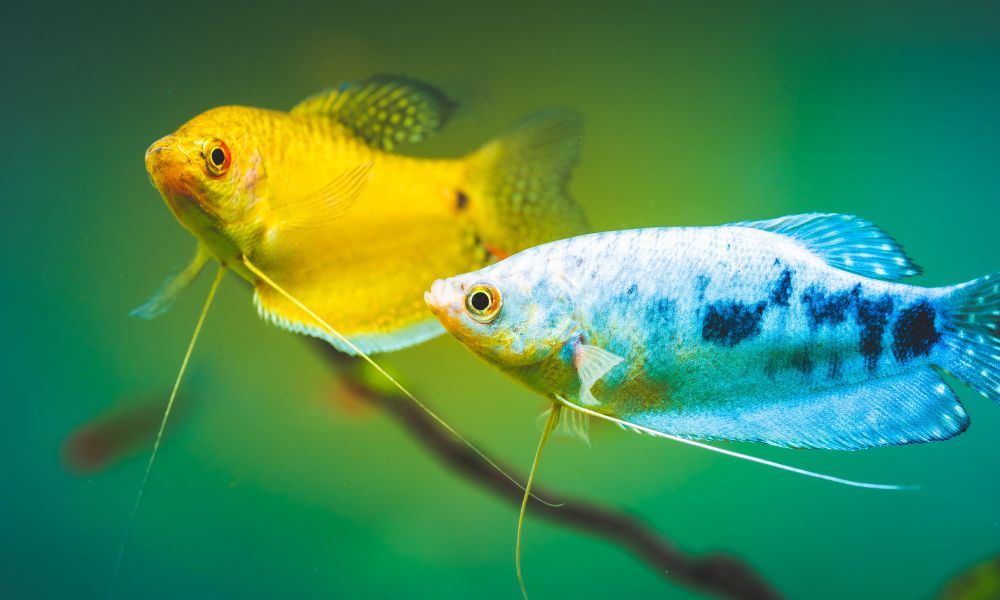
| Attribute | Description |
| Size | 2 to 6 inches (varies by species) |
| Diet | Omnivore |
| Temperament | Peaceful to Semi-Aggressive |
| Care Level | Intermediate |
| Minimum Tank Size | 20 to 30 gallons (varies by species) |
Gouramis, often adorned with radiant colors and elegant fins, are a diverse group of freshwater fish belonging to the Osphronemidae family.
Native to parts of Asia, they are labyrinth fish, which means they possess a unique organ allowing them to breathe atmospheric air. This trait often results in them making frequent trips to the surface.
7. Bristlenose Plecos
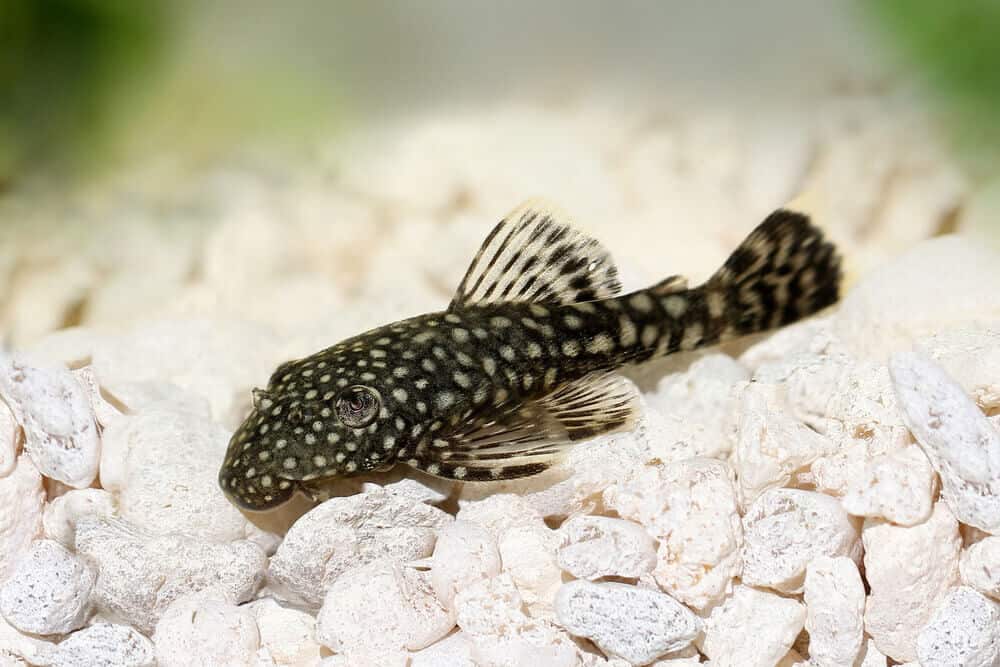
| Attribute | Description |
| Size | 4 to 6 inches |
| Diet | Herbivore (Algae eater) |
| Temperament | Peaceful |
| Care Level | Easy to Intermediate |
| Minimum Tank Size | 30 gallons |
Bristlenose Plecos sometimes referred to as Bristlenose Catfish, are a popular species among aquarists, renowned for their unique appearance.
Sporting tentacle-like growths on their snouts (more pronounced in males), they are often sought after not just for their distinct look but also for their ability to combat algae growth in tanks.
8. Mollies and Platies
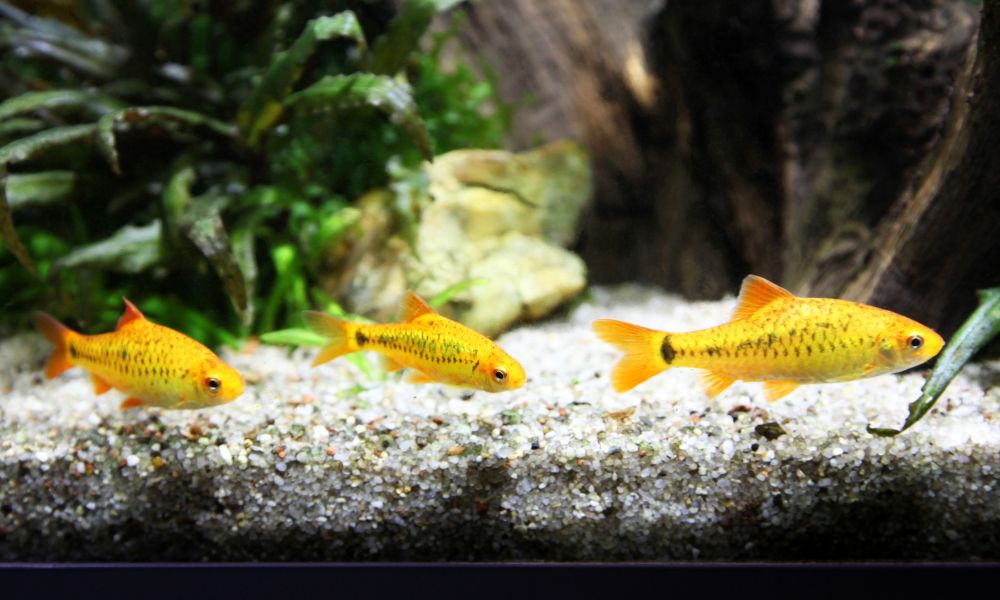
| Attribute | Mollies Description | Platies Description |
| Size | 3 to 4 inches | 1.5 to 2.5 inches |
| Diet | Omnivore | Omnivore |
| Temperament | Peaceful | Peaceful |
| Care Level | Easy | Easy |
| Minimum Tank Size | 20 gallons | 10 gallons |
Mollies and Platies are both members of the Poeciliidae family and are appreciated for their vibrant colors and ease of care. They bring a splash of color and activity to community tanks, making them popular choices among both novice and experienced aquarists alike.
9. Rainbowfish
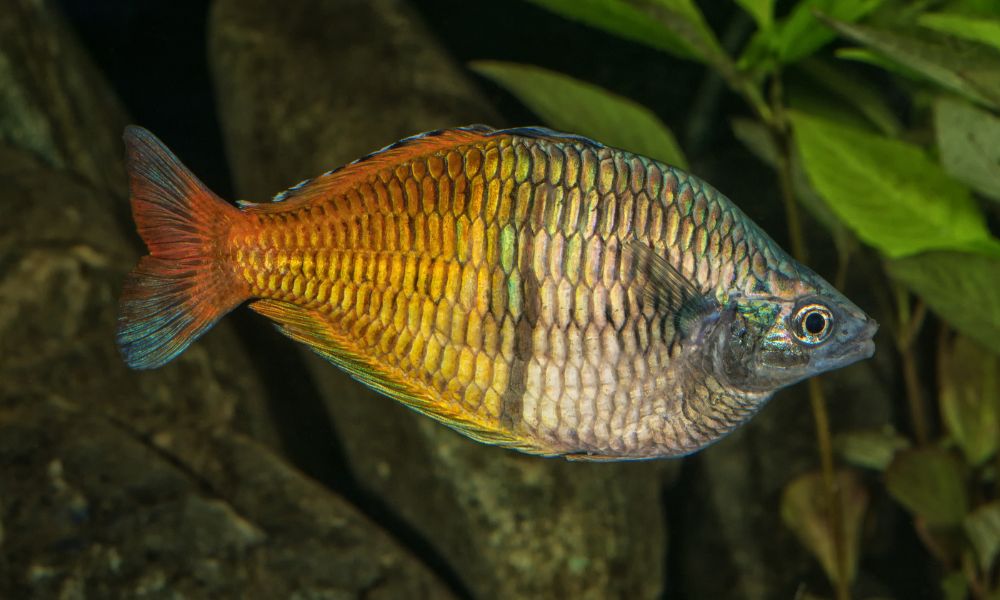
| Attribute | Description |
| Size | 2 to 4 inches |
| Diet | Omnivore |
| Temperament | Peaceful to Active |
| Care Level | Intermediate |
| Minimum Tank Size | 20 to 30 gallons |
Rainbowfish, hailing primarily from the freshwater lakes and rivers of Australia, New Guinea, and Indonesia, are aptly named for their striking, iridescent colorations. As the light hits them, their scales can shimmer and shine in an array of dazzling colors, creating a vibrant display reminiscent of a rainbow.
10. Ghost Shrimp
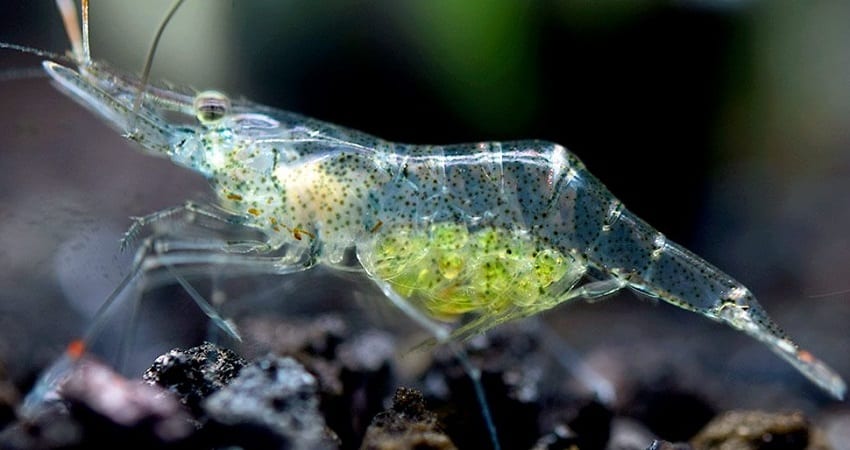
| Attribute | Description |
| Size | 1 to 2 inches |
| Diet | Omnivore, detritivore |
| Temperament | Peaceful |
| Care Level | Easy |
| Minimum Tank Size | 10 gallons |
Ghost Shrimp, often known as Glass Shrimp, are small, translucent crustaceans that are a fascinating addition to freshwater tanks. Their nearly transparent bodies offer a unique view into the workings of their internal organs, making them a favorite among many hobbyists.
11. African Dwarf Frogs
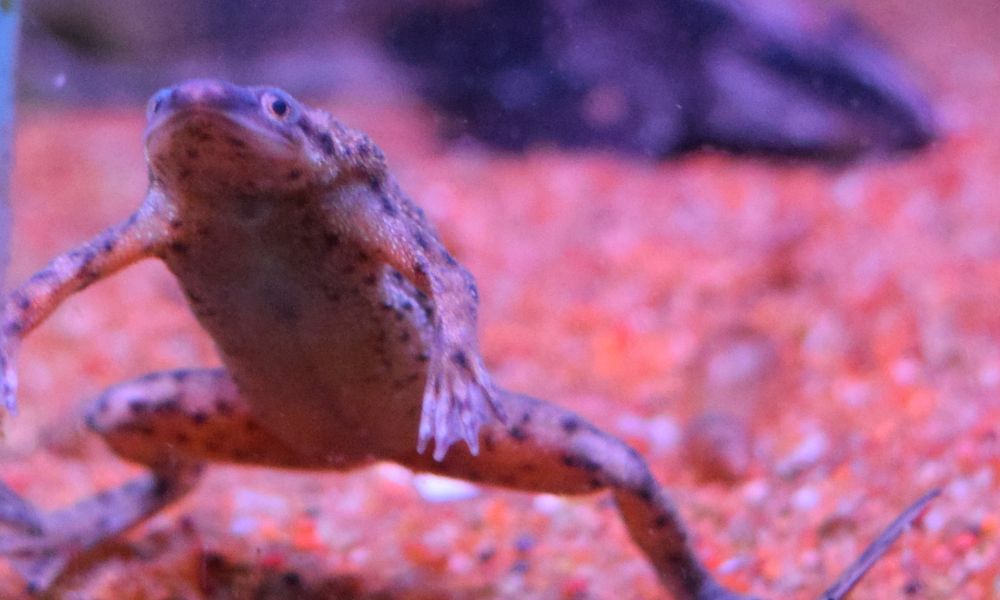
| Attribute | Description |
| Size | 1 to 2.5 inches |
| Diet | Carnivore |
| Temperament | Peaceful |
| Care Level | Intermediate |
| Minimum Tank Size | 10 gallons |
African Dwarf Frogs are fully aquatic amphibians known for their tiny stature and characteristic, often comical, swimming patterns. Native to freshwater ponds and rivers in Central and West Africa, these frogs have webbed feet, a sleek body, and a penchant for “hopping” around in the water, making them intriguing tank inhabitants.
Unlike many frog species, African Dwarf Frogs are entirely aquatic, meaning they live their whole lives submerged. While they do need to surface for air periodically, they don’t require any terrestrial area in the tank.
Male African Dwarf Frogs are known to “sing” or hum, especially during the mating season. This sound is a unique call that adds a distinct audio element to the tank environment.
12. Otocinclus Catfish
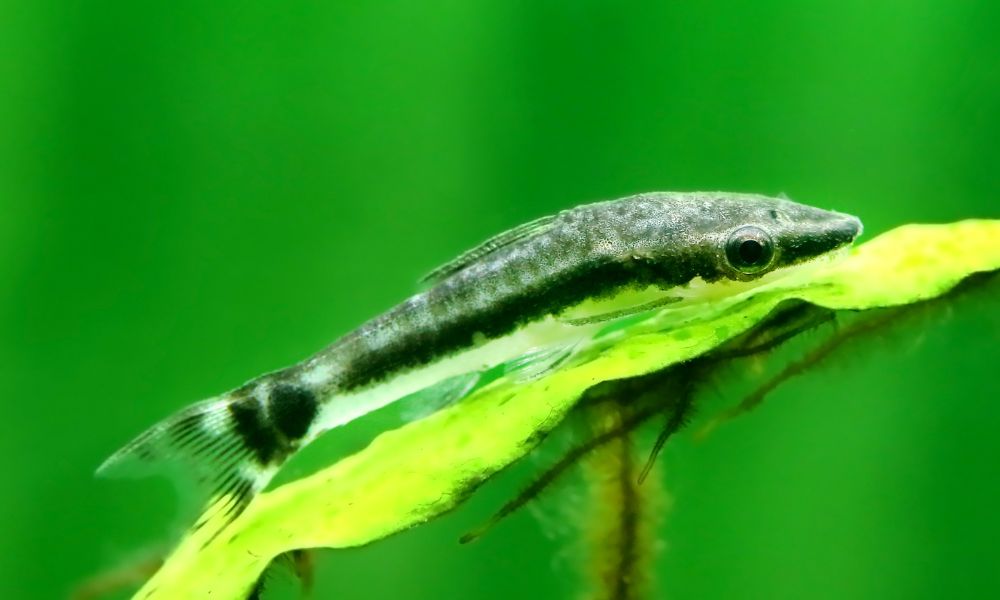
| Attribute | Description |
| Size | 1 to 2.5 inches |
| Diet | Carnivore |
| Temperament | Peaceful |
| Care Level | Intermediate |
| Minimum Tank Size | 10 gallons |
Otocinclus Catfish, often simply called “Otos”, are small, streamlined catfish that hails from South America’s freshwater rivers and streams.
Known for their diligent algae-eating habits and peaceful nature, they’ve become favorites for aquarists seeking a natural solution to tank maintenance.
Otocinclus are among the most peaceful catfish, showing no aggression towards other tank mates. Their gentle nature ensures they coexist harmoniously with Barbs without causing any disruptions.
One of the standout qualities of the Otocinclus is their appetite for algae, especially the kind that often forms on plant leaves and tank walls.
13. Snails
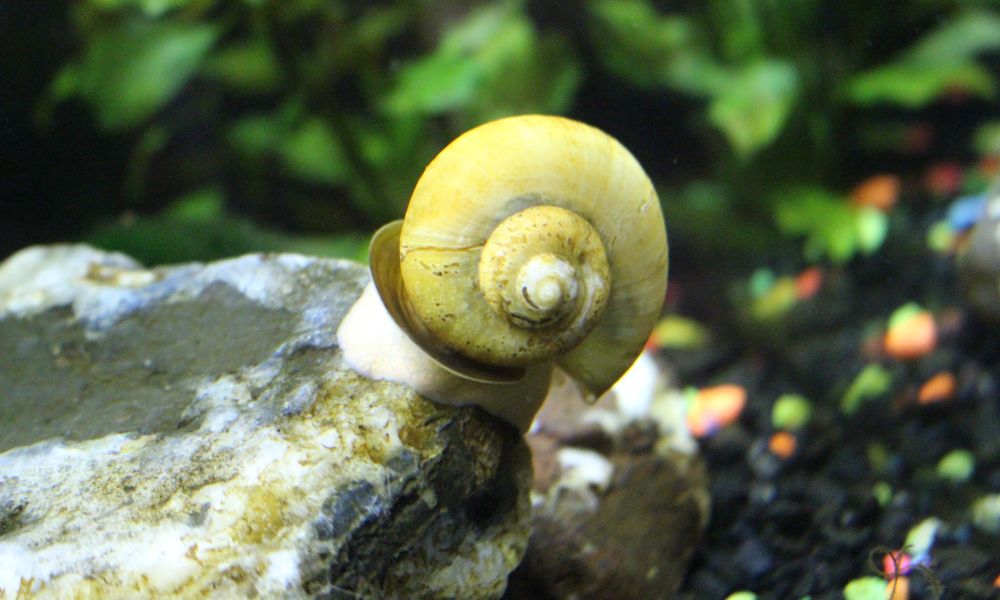
| Attribute | Nerite Snails Description | Mystery Snails Description |
| Size | Up to 1 inch | 1 to 2 inches |
| Diet | Herbivore | Omnivore |
| Temperament | Peaceful | Peaceful |
| Care Level | Easy | Easy |
| Minimum Tank Size | 5 gallons | 10 gallons |
Both Nerite Snails and Mystery Snails have become increasingly popular in freshwater tanks due to their aesthetics, peaceful temperament, and the functional roles they play in maintaining tank health. With their unique patterns and ornate shells, snails can be a beautiful addition to an aquarium.
Tips for Introducing New Tank Mates
Introducing new tank mates into an established aquarium can be a daunting process. To ensure a smooth transition and minimize stress for all aquatic inhabitants, certain guidelines and methods should be followed.
Acclimatization Methods
The process of acclimatization eases the transition for fish from one environment to another, ensuring they adapt to the temperature, pH, and other water parameters of their new home.
1. Floating Bag Method
- Keep the bag in which the new fish were transported floating on the surface of your aquarium for about 15-20 minutes. This helps to equalize the temperature.
- After the temperature has been equalized, open the bag and introduce a small amount of your tank water into it.
- Every 5-10 minutes, add more tank water to the bag. Repeat this for about an hour.
- Use a net to gently transfer the fish from the bag to the tank. Avoid pouring water from the bag into your aquarium.
2. Drip Acclimatization
- Set the bag with the new fish in a bucket.
- Use airline tubing to create a siphon from your aquarium to the bucket. Knot the tubing to control the flow or use a drip acclimatization kit.
- Allow water to drip from the tank into the bucket at a slow rate (about 2-4 drips per second).
- Once the water volume in the bucket has doubled, you can net the fish and introduce them to the tank.
Monitoring for Aggressive Behavior
Observing fish behavior is crucial after introducing new tank mates. Here’s how to go about it:
1. Initial Observation
Immediately after introduction, keep a close eye on both the new and established fish. Check for signs of chasing, nipping, or other aggressive behaviors.
2. Identify Territorial Zones
Some fish are territorial and might not appreciate newcomers. Familiarize yourself with such zones in your tank and observe how newcomers navigate them.
3. Use a Quarantine Tank
Before introducing any new fish into your main tank, keep them in a quarantine tank for a couple of weeks. This ensures they’re healthy and also gives you a chance to observe their behavior in isolation.
4. Provide Plenty of Hiding Spots
Ensure your tank has enough plants, caves, and other hiding spots. This offers shelter for the newbies, especially if they’re being chased or bullied.
5. Feed Adequately
Make sure all fish get their share of food. Sometimes, aggression can be a result of competition for food.
6. Feed Adequately
Overcrowding can lead to increased aggression. Ensure your tank size is suitable for the number and species of fish you keep.
7. Regular Monitoring
While the first few hours post-introduction are crucial, it’s essential to continue observing fish behavior over several days. Aggressive tendencies can manifest later as fish establish new territories or hierarchies.
Conclusion
When introducing new tank mates, it’s vital to acclimate them properly and observe their behavior closely. With patience and care, you can ensure a harmonious and healthy aquarium environment.






